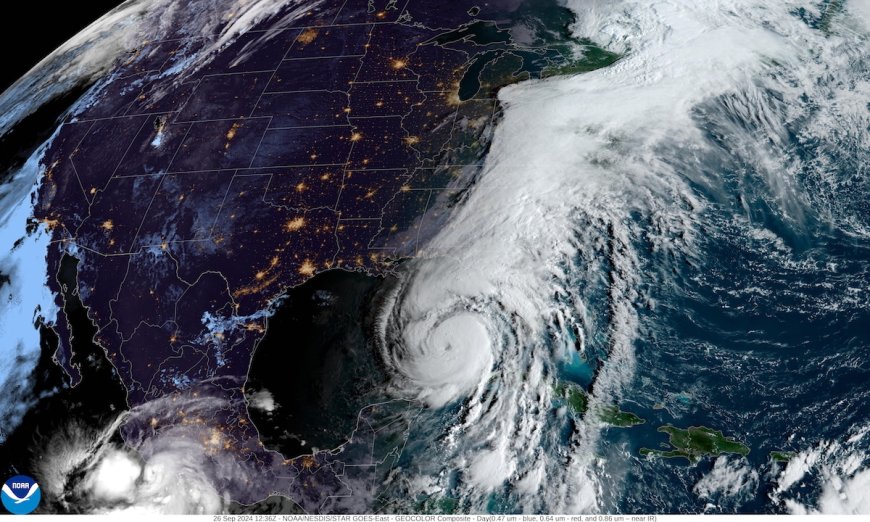NOAA: 2025 Atlantic Hurricane Season Predicted to Be Above Normal With 13 to 19 Named Storms
The United States National Oceanic and Atmospheric Administration (NOAA)’s outlook for the 2025 Atlantic hurricane season — June 1 to November 30 — predicts a 60 percent chance of it being “above normal,” a 30 percent chance of it being near normal and a 10 percent chance that it will be below normal. The agency […] The post NOAA: 2025 Atlantic Hurricane Season Predicted to Be Above Normal With 13 to 19 Named Storms appeared first on EcoWatch.

The United States National Oceanic and Atmospheric Administration (NOAA)’s outlook for the 2025 Atlantic hurricane season — June 1 to November 30 — predicts a 60 percent chance of it being “above normal,” a 30 percent chance of it being near normal and a 10 percent chance that it will be below normal.
The agency forecasts that there will be 13 to 19 named storms with winds 39 miles per hour (mph) or higher. Of those, between six and 10 are predicted to become hurricanes with 74 mph or higher winds, including from three to six major hurricanes of category 3, 4 or 5 with 111 mph-plus winds.
The prediction for an above-normal season is due to a combination of factors that have a tendency to favor the formation of tropical storms, including warmer ocean temperatures, continuing ENSO-neutral conditions, a weak wind shear forecast and the possibility of increased activity from the West African Monsoon — a key starting point for hurricanes in the Atlantic, a press release from NOAA said.
Higher ocean temperatures in the Atlantic Basin means more energy for the development of storms, while reduced trade winds allow storms to develop unabated. The potential for the West African monsoon to shift northward could produce tropical waves that can be the seeds for some of the longest and strongest Atlantic storms.
“This outlook is a call to action: be prepared. Take proactive steps now to make a plan and gather supplies to ensure you’re ready before a storm threatens,” said Ken Graham, director of NOAA’s National Weather Service, in the press release.
NOAA said this season it will improve forecast communications. Among the improvements is that advance notice of potential tropical cyclone risks will be provided by the NOAA Climate Prediction Center’s Global Tropical Hazards Outlook three weeks ahead of time instead of two, providing extra time for people to prepare.
“As we witnessed last year with significant inland flooding from hurricanes Helene and Debby, the impacts of hurricanes can reach far beyond coastal communities,” said Acting NOAA Administrator Laura Grimm. “NOAA is critical for the delivery of early and accurate forecasts and warnings, and provides the scientific expertise needed to save lives and property.”
However, some scientists fear the country is not as prepared as it was a year ago, reported The Washington Post. NOAA’s workforce has been depleted by the firing of probationary workers and early retirements, bringing staff numbers down from roughly 12,000 to about 10,000, according to Rick Spinrad, who was administrator of the agency under President Joe Biden.
The cuts have led to staff shortages of up to 30 percent in major divisions throughout the agency, including “hurricane hunters” who fly into the heart of the storms, workers who launch local weather balloons and climate scientists who maintain models used to predict the intensity and track of hurricanes.
“Even if we have an average season, I think we’re going to be stretching the limit of [NOAA’s] capabilities,” Spinrad said, as The Washington Post reported.
An average hurricane season in the Atlantic means 14 named storms, seven of which become hurricanes, with three major hurricanes.
The Federal Emergency Management Agency (FEMA) leads the country’s disaster response and recovery, but repeated calls from the Trump administration and Secretary of the Department of Homeland Security (DHS) Kristi Noem to “eliminate” FEMA have caused internal confusion about the agency’s mission, including how fast its response should be to states’ disaster requests, reported CNN.
“When it’s taking months for a disaster declaration to be granted, the people on the ground could potentially think, well, FEMA is just not going to be here because they’re gone, because the president and the (DHS) secretary got rid of them,” said Deanne Criswell, former FEMA chief under President Biden, as CNN reported.
NOAA’s 2025 outlook is for overall hurricane season activity, not a landfall forecast. NOAA has also issued hurricane outlooks for the central Pacific and eastern Pacific hurricane basins.
The 2025 Atlantic hurricane season outlook will be updated by the Climate Prediction Center in early August, before the season’s historical peak.
The post NOAA: 2025 Atlantic Hurricane Season Predicted to Be Above Normal With 13 to 19 Named Storms appeared first on EcoWatch.



















































